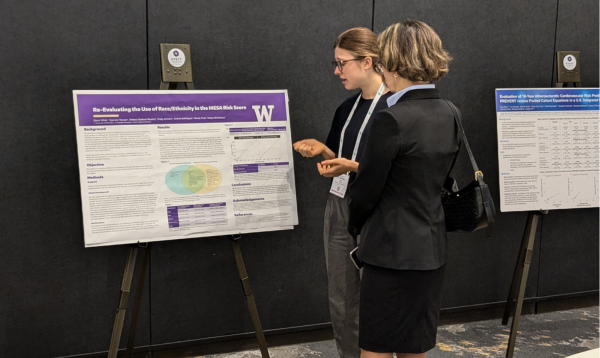Biostatistics students have opportunities to participate in real-world research projects that impact the health of people and their communities. Below are a few examples of such projects.
Assessing the implications of using race/ethnicity in predicting health risk

Doctoral Student Quinn White's research is part of a growing effort to assess the implications of including race and ethnicity in clinical risk prediction models. White was first author of a recent study assessing the implications of not including race and ethnicity in clinical risk prediction models. The team examined the use of race in the Multi-Ethnic Study of Atherosclerosis (MESA) algorithm used to calculate the 10-year risk of coronary heart disease and compared it to an updated version that did not include race/ethnicity. Findings revealed the score calculation not using race predicted heart disease as well as the original calculation that did.
Putting theory into practice
As a master's level statistician working in biomedical research, Kat Hoffman experienced first-hand the gap between novel methods being produced and the tools front-line analysts are actually able to use in their day-to-day work. This spurred Hoffman to return to school to pursue a PhD in biostatistics to bridge the divide between methodological development for statistics and applied biostatistics.
Excavating answers from massive health data sets
First-year PhD student Jasper Yang is part of a Kaiser Permanente Health Research Institute team that is developing statistical methods to analyze electronic health records (EHR) in order to answer questions about HIV treatments and better understand the disease in general.
Supporting local health care organizations and government
Applying what they learned in the Master of Science Capstone program to address real-world problems in public health, last year’s student capstone teams engaged with healthcare organizations focusing on improving patient care, and a Washington state government organization engaged in optimizing healthcare planning and resource allocation.
Research work in the field with internships
Last summer, students tackled a broad range of research challenges including the impact of biofuel assumptions on energy projections, analyzing brain grey matter patterns in Alzheimer’s patients to link disease progression to cognitive assessment, and exploring data relating to exonerations and wrongful incarcerations to further understand the impact of Innocence Organizations on state exonerations rates.
Interested in our programs? Learn more about the PhD, MS Capstone, and MS Thesis programs.